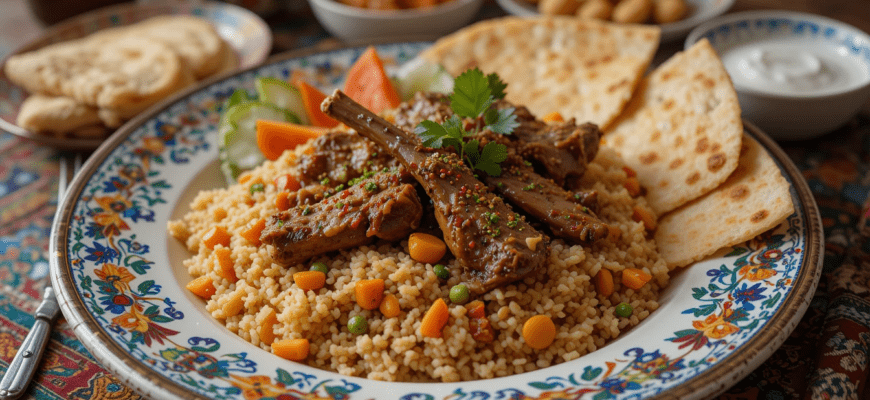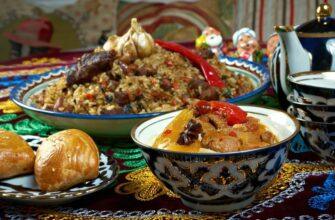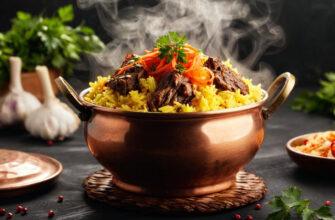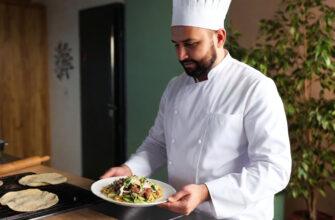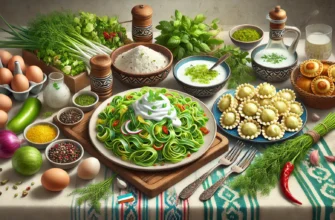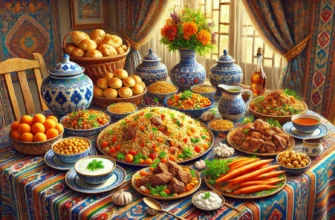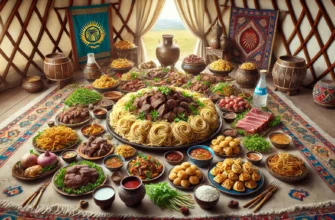Embarking on a culinary journey can be one of the most enriching experiences, unveiling the rich tapestry of flavors that a culture offers. Uzbekistan, nestled along the ancient Silk Road, boasts a cuisine steeped in history and tradition, with its dishes telling stories of the land and its people.
At the heart of Uzbek cuisine lies plov, a savory rice dish that has gained legendary status. This article will dive deep into the origins, variations, and techniques behind plov, while also exploring the diverse array of accompanying dishes that showcase Uzbekistan’s culinary brilliance.
Whether you’re a seasoned chef or a curious food lover, you’ll discover essential tips on creating authentic Uzbek meals. Join us as we uncover the flavors of Uzbekistan, starting with the revered plov.
Uzbek Plov: The Heart of Uzbek Cuisine
Uzbek Plov, also known as Osh or Плов, is a beloved national dish of Uzbekistan. This hearty one-pot meal features long grain rice, lamb or beef, carrots, onions, and garlic. Spices like Barbaris and cumin give it a unique flavor. Traditionally, Plov is cooked outdoors in a large cauldron called a Kazan, over an open fire.
Plov is more than just a meal—it’s a cultural experience. It’s often served with Achichuk Salad and is a central dish during weddings and large gatherings. Each region in Uzbekistan has its own version of Plov, showcasing local ingredients and spices.
Here’s what you need for homemade Plov:
- Rice: Long grain
- Meat: Lamb or beef
- Vegetables: Carrots, onions
- Spices: Barbaris, cumin
- Extras: Head of garlic
Each preparation of Plov creates a sense of pride and community. Whether enjoyed at a festive event or a simple family dinner, this dish is the heart of Uzbek cuisine. Try making it yourself to appreciate its rich flavors and cultural significance.
Traditional Preparation: Cooking Techniques of Plov
Plov is a beloved traditional dish in Uzbekistan. It is traditionally prepared in a large cast-iron pot called a Kazan. Often, the cooking happens outdoors over an open fire. This enhances the dish’s flavors.
One secret to a tender Plov is preparing “Zervak.” This involves simmering meat in water for over an hour. The result is meat that falls off the bone. Different types of rice, such as basmati, jasmine, and Calrose, are used. Each type has its own cooking time.
Plov is a one-pot dish that includes rice, meat (like lamb or beef), carrots, onions, and spices. These ingredients create a rich flavor profile. Unlike some dishes, Plov emphasizes layering ingredients. This technique helps maintain distinct flavors.
Here is a basic list of Plov’s components:
- Meat (Lamb or Beef)
- Rice (Basmati, Jasmine, or Calrose)
- Carrots
- Onions
- Spices
Cooking Plov is not just about mixing. It is more about careful preparation and layering. This method ensures every bite is full of the unique flavors that make Plov a standout in Uzbek cuisine.
Variations of Plov: From Lamb to Vegetarian Options
Uzbek plov is a national dish cherished for its rich flavors and versatility. Traditionally, it features lamb, but beef and chicken are popular alternatives. These meats are combined with rice, carrots, onions, and spices to create a hearty dish.
Different types of rice are crucial for the perfect plov texture. Popular choices include Basmati, jasmine, and white rice. Each variety brings its own unique touch to the dish.
Here are some common ingredients you might find in plov:
- Meats: Lamb, beef, chicken, pork, or even wild game
- Additions: Raisins, chickpeas, or beans
- Spices: Cumin seeds, black pepper, garlic cloves
For a sweeter twist, plov can include raisins, often dark ones, to enhance its flavor profile. Chickpeas are another common addition, offering a hint of nuttiness.
For vegetarians, plenty of options exist too. By replacing meat with beans or more vegetables, the dish remains flavorful and filling. The adaptability of plov makes it a beloved dish in Uzbekistan and beyond, catering to various taste preferences and dietary needs.
Rice Selection: Choosing the Right Rice for Plov
Choosing the right rice is crucial for making a perfect Uzbek plov. Long-grain rice is the best choice due to its starch content, which prevents sticking and retains its texture during cooking. Parboiled rice is closest to what is traditionally used in authentic Uzbek plov recipes. It balances texture and flavor well.
Here is a quick guide for rice selection in plov:
- Long-Grain White Rice
-
- Ideal for separate, tender grains
- Prevents mushy texture
- Basmati or Jasmine Rice
-
- Adds a fragrant touch
- Suitable for a flavorful plov
- Long-Grain Brown Rice
-
- Healthy option
- Maintains texture well
- Short-Grain Whole Grain Rice
-
- Not recommended
- Leads to undesired stickiness
Remember, rinsing the rice before cooking is essential. This step removes excess starch and helps achieve the ideal texture. In Uzbekistan, the perfect plov has grains that are separate, tender, yet firm. A mushy or sticky plov is considered less desirable. Follow these tips for the best results!
Spices and Aromatics: Essential Ingredients for Flavor
Uzbek Plov is a popular dish known for its rich flavors and aroma. The unique spice blend of paprika, cumin, and garlic plays a key role in its taste. These spices, along with the traditional use of cumin seeds, highlight the importance of Central Asian cuisine.
Key Ingredients:
- Spices:
-
- Paprika
- Cumin
- Garlic
- Vegetables:
-
- Onions
- Carrots
- Optional Additions:
-
- Raisins
- Chickpeas
The preparation of Plov often includes onions and carrots. These vegetables enhance the dish’s taste and texture. Aromatic basmati rice is essential in this dish to achieve a fluffy texture while absorbing the spices effectively.
Here’s a simple spice list for making Uzbek Plov:
| Ingredient | Purpose |
|---|---|
| Paprika | Adds color and mild heat |
| Cumin | Offers earthy and nutty flavors |
| Garlic | Provides a robust, pungent taste |
Including raisins or chickpeas can add depth and richness to the flavor. By following these ingredients, you can recreate the authentic taste of Uzbek Plov in your kitchen.
Meat Choices: Best Cuts for Cooking Plov
When cooking traditional plov, selecting the right meat is crucial. For a classic taste, lamb is ideal. Its rich, savory flavor defines the dish. Recommended cuts include:
- Bone-in Pork Shoulder
- Bone-in Leg
- Sirloin Chop
These cuts provide marrow, adding a fantastic fatty flavor to the plov.
For a beef alternative, here are great options:
- Short Ribs
- Ribeye
- New York Strip
- Stew Meat
- Chuck Roast
Beef plov offers a distinct yet delightful flavor profile. Including bones not only enhances taste but also adds authenticity to the dish. It’s a simple tip for improving the dining experience.
Quick Tip: Salt your meat overnight before cooking to tenderize and deepen its flavor.
Here’s a summary table:
| Meat Type | Recommended Cuts |
|---|---|
| Lamb | Pork Shoulder, Leg, Sirloin Chop |
| Beef | Short Ribs, Ribeye, Strip, Chuck |
Utilize these cuts for the best plov experience!
Serving Suggestions: How to Present Plov
Plov, Uzbekistan’s national dish, is more than just a hearty rice meal. When it comes to serving, presentation is key. Here’s how to make it look and taste amazing.
- Garnish and Enhance Flavor
Traditionally, plov is garnished with whole garlic heads and chilies. These not only add flavor but also create an appealing look. - Serve with Achik Chuchuk Salad
Pair plov with achik chuchuk, a fresh salad of sliced tomatoes and onions. For an extra touch, add cucumbers and hot peppers. - Pair with Green Tea
Complement the richness of plov with hot green tea. It’s a common practice that balances the flavors wonderfully. - Use a Large Warmed Plate
For a welcoming presentation, serve plov on a large warmed plate. This helps keep the dish hot and enticing. - Add Fresh Herbs
Sprinkle fresh herbs like mint, cilantro, or dill over the plov. This adds both color and a burst of fresh flavor.
By following these steps, you can elevate plov to new heights. Enjoy it the way it’s meant to be savored!
Leftover Love: Storing and Reheating Plov
Plov, a hearty and popular Uzbek dish, can be a delight even as leftovers. Proper storage is essential to maintain its flavor. For short-term storage, let your plov cool to room temperature. Then, transfer it to an airtight container and refrigerate for up to a week. For longer storage, freeze meal-sized portions in freezer-safe bags. Label each with the date to prevent freezer burn and enjoy for up to three months.
Reheating plov is simple and can be done in several ways. To rehydrate the rice, microwave it with a splash of water. Alternatively, warm it in a skillet with a bit of butter or oil. For an oven option, cover the plov and heat it in a 350°F oven until thoroughly hot. Another method is to fry the leftovers in a lightly greased non-stick skillet for a crispy texture.
Here’s a quick reference:
| Method | Details |
|---|---|
| Microwave | Splash of water to rehydrate rice |
| Skillet | Use a bit of butter or oil |
| Oven (350°F) | Cover and heat until thoroughly hot |
| Frying | Use a non-stick skillet |
Enjoy your plov again with just a little effort!
Other Traditional Dishes: Beyond Plov
Uzbek cuisine goes beyond the famous plov, showcasing a diverse range of traditional dishes. Here’s a glimpse into some other culinary delights of Uzbekistan:
- Lagman – A hearty noodle dish, often served with beef or lamb, vegetables, and a rich broth. This dish is popular for its blend of flavors and textures.
- Manti – These are steamed dumplings filled with spiced meat like lamb or beef. Manti is often served with sour cream or a tangy tomato sauce.
- Samsa – These are savory pastries resembling a turnover, filled with meat, pumpkin, or potato, and baked until golden.
- Shurpa – A traditional soup made with lamb, vegetables, and fragrant herbs, ideal for cold winter days.
- Naryn – A dish made from hand-pulled noodles and horse meat. It’s a classic Uzbek meal enjoyed during celebrations.
Embracing simplicity, these dishes emphasize fresh ingredients and communal dining. They are staples during family gatherings and represent the rich tapestry of regional influences in Uzbek cuisine. While plov remains the quintessential choice, exploring beyond it reveals the true depth of Uzbekistan’s culinary heritage.
Manti: Uzbek Dumplings Worth Trying
Manti are delicious dumplings you should try if you’re exploring Uzbek cuisine. They are filled with seasoned meat, usually lamb or beef, and sometimes mixed with veggies. Spices add a unique flavor to these bites. Typically, manti are steamed. This makes them tender and juicy, bringing out the rich taste of the filling.
Manti hold a special place in Uzbek food culture. They’re often enjoyed at celebrations and special gatherings, similar to the beloved plov. Some recipes include a blend of meat and fat, enhancing the richness. Serving them with a dipping sauce is common, which provides a nice contrast. These sauces are often yogurt or tomato-based, adding a refreshing taste to each bite.
Here’s what makes manti special:
- Main Ingredients: Seasoned lamb or beef
- Cooking Method: Steamed
- Common Spices: Various, depending on taste
- Serving Style: With yogurt or tomato sauce
Next time you’re indulging in Uzbek cuisine, don’t miss out on manti. Their savory and tender taste, paired with a tangy sauce, makes these dumplings an unforgettable experience.
Lagman: A Flavorful Noodle Dish
Lagman is a flavorful noodle dish that is a staple in Central Asian cuisine. This popular dish features hand-pulled noodles which are often paired with a delightful mix of vegetables and meats. The skillful preparation of these noodles adds a unique texture, making Lagman stand out.
One of the most appealing aspects of Lagman is its versatility. You can personalize it to suit different tastes and occasions, making it a favorite for any meal. The variety of sauces and spices used in Lagman enhances its savory profile, delivering a rich culinary experience.
Lagman is often enjoyed with other traditional Central Asian dishes, showcasing the region’s diverse food culture. It is not just about the noodles; it’s about the whole experience of eating together and savoring the flavors.
To fully enjoy Lagman, it is important to master the art of hand-pulling noodles. This adds a distinct texture that makes the dish so special. Whether you’re a fan of spicy or mild flavors, Lagman can be adjusted to your liking, proving its adaptability and timeless appeal.
Samsa: Savory Pastries for Every Occasion
Samsa is a beloved savory pastry in Uzbek cuisine. These hearty parcels are perfect for any occasion and are enjoyed as a snack or part of a meal. Made with flaky dough and filled with various ingredients, Samsa can include minced meat, onions, and spices.
Typical Samsa Ingredients:
- Minced beef or lamb
- Onions
- Black pepper
- Cumin seeds
The pastries are usually baked until golden brown, resulting in a crispy texture. Samsa is often sold as popular street food throughout Uzbekistan, making it a quick and satisfying option for locals and tourists alike.
Occasions for Samsa:
- Family gatherings
- Street festivals
- Daily snacks
While the preparation may vary by region, the love for Samsa is widespread across Uzbekistan. Whether you are on a food tour or exploring traditional dishes, trying Samsa is a must. Packed full of fresh ingredients, this Uzbek delight is a testament to the flavorful and comforting nature of Central Asian cuisine.
Shashlik: Grilled Meats with a Twist
Shashlik is a beloved dish in Uzbekistan, often prepared by men during weddings and special events. This grilled delight consists of marinated meat chunks skewered and cooked over an open flame. It’s a culinary treasure in Central Asia and the former Soviet Union, cherished for its comforting flavors.
Variations and Traditions:
- Meat Types: Lamb, beef, and chicken are popular choices.
- Marinades: Each region has its own secret mix, often sparking debates on the “right” recipe.
- Accompaniments: Served with salads and condiments to enhance the taste.
Shashlik’s preparation is steeped in centuries of tradition, symbolizing unity and festivity in Uzbek culture. Like Uzbek Plov, it plays a pivotal role at gatherings, making it more than just a meal—it’s an experience. Despite its rustic roots, Shashlik continues to adapt, with each family adding their unique twist.
For those exploring Uzbek cuisine, Shashlik is a must-try. Its flavor, history, and cultural importance make it an unforgettable dish that bridges generations and regions. Enjoy it with friends and family for a true taste of Uzbekistan.
Non: The Essential Uzbek Bread
Non is more than just bread in Uzbekistan; it is essential to every meal, especially with plov, the national dish. At Besh Qozon, one of Uzbekistan’s most famous plov restaurants, the preparation of non takes on a special spiritual importance. The nonvoy, or baker, performs a ritual before starting his work, asking for blessings and purifying himself. This highlights non’s cultural and religious significance.
Each day, the nonvoy at Besh Qozon bakes over 3,000 loaves to meet the demands of thousands of customers. Traditionally, in family homes, women bake non with care. However, in restaurants, male bakers are often responsible, showcasing the bread’s pivotal role in both domestic and commercial kitchens.
Table: Non Facts
| Fact | Detail |
|---|---|
| Location | Besh Qozon, Uzbekistan |
| Daily Production | Over 3,000 loaves |
| Cultural Importance | Both family and restaurant settings |
Non’s preparation is a revered task, highlighting the bread’s importance in Uzbek culinary traditions. It is not simply food but a symbol of shared meals and heritage, making non truly indispensable in Uzbek cuisine.
Uzbek Tea: The Perfect Accompaniment
Uzbek cuisine is known for its rich flavors and diverse dishes. One essential item that complements these meals is Uzbek tea. Known in the region as “chai,” this tea is enjoyed both before and after meals. It’s a staple in Uzbek households and pairs perfectly with the country’s beloved dishes like Plov.
Key Features of Uzbek Tea:
- Variety: Green and black teas are the most common types.
- Preparation: Often brewed with a few simple steps, maintaining the traditional essence.
- Serving Style: Poured into small bowls called “pialas” for sipping.
Tea in Uzbekistan is more than just a beverage; it’s a social ritual. When guests arrive, they’re welcomed with a warm pot of tea. This gesture underscores hospitality, making visitors feel at home.
How Tea Enhances Uzbek Meals:
- Refreshing: Tea cleanses the palate after the hearty, flavorful Plov.
- Digestive Aid: It aids in digestion, making it a suitable end to a meal.
Pairing Plov with Uzbek tea not only balances the flavors but also enriches the dining experience, making it a must-try for anyone exploring Uzbek cuisine.
Uzbek Desserts: Sweet Treats to Savor
Uzbek desserts are a delightful reflection of the region’s rich cultural heritage. They are often enjoyed alongside main dishes like the hearty plov. These sweet treats feature simple ingredients, highlighting the use of local fruits and nuts. Sweetness in Uzbek desserts usually comes from dried fruits, honey, and nuts, echoing the flavors found in savory dishes.
Popular Uzbek Desserts:
- Halva: A dense confection made from seeds or nuts, sweetened with honey.
- Pakhlava: Layered pastry filled with nuts and sweetened with syrup.
- Nishalda: A fluffy, meringue-like desert made with egg whites and sugar.
Many of these sweets are deeply rooted in celebrations and family gatherings. This makes them a mirror to the communal experience of sharing plov. Whether served at weddings or enjoyed with loved ones, these desserts hold a special place in Uzbek culture.
| Dessert | Key Ingredients |
|---|---|
| Halva | Seeds, Nuts, Honey |
| Pakhlava | Nuts, Syrup, Pastry |
| Nishalda | Egg Whites, Sugar |
So, the next time you have a taste of Uzbekistan, don’t forget to savor these sweet delights!
Cultural Significance: Food in Uzbek Traditions
Food is at the heart of Uzbek culture, and plov is its crown jewel. This national dish is as cherished in Uzbekistan as pasta is in Italy. Plov isn’t just food; it’s a symbol of hospitality and tradition.
When is Plov Served?
- Weddings
- Holiday Parties
- Birthdays
These are popular occasions for serving plov because it plays a role in celebrations and gatherings.
The Story of Spices
Cumin, a key spice in plov, traveled to Uzbekistan via the Silk Road. This highlights the cultural influences on Uzbek cuisine over time.
Traditions and Beliefs
Thursdays and Sundays are special days for making and eating plov. This tradition is tied to historical economic patterns and cultural beliefs. There’s also a belief that plov is an aphrodisiac. This emphasizes its cultural importance.
Plov’s role doesn’t just stop at being a meal. It strengthens social and familial bonds, underscoring the belief in food’s importance in relationships. Uzbek food, with its rich flavors and deep traditions, continues to be a source of pride for the nation.
Dining Etiquette: How to Enjoy Uzbek Meals
Dining in Uzbekistan is a rich cultural experience steeped in tradition. At the heart of Uzbek meals is plov, the national dish, often viewed as comfort food essential for family gatherings and celebrations.
Key Elements of Uzbek Dining:
- Plov: This hearty rice dish is central and must be accompanied by non (bread). Bread signifies hospitality and is revered in Uzbek culture.
- Gender Roles: During large gatherings or in restaurants, male chefs, known as oshpaz, typically prepare plov. However, at home, women traditionally take on this role.
- Fresh Ingredients: Authenticity is key. The use of fresh, local ingredients is crucial in Uzbek cooking, emphasizing quality and taste.
- Ceremonial Preparation: The preparation is almost sacred. The chef purifies himself and asks for a blessing, highlighting the cultural significance of cooking.
Quick Tips for Enjoying Uzbek Meals:
- Always have a piece of non with your meal.
- Appreciate the chef’s role, whether a skilled oshpaz or a home cook.
- Savor the fresh flavors.
- Observe the ritualistic aspects, which add depth to the dining experience.
Embrace the warmth and tradition of Uzbek dining, where every meal is a celebration.
Food Markets: Where to Find Authentic Ingredients
Uzbek markets are havens for food lovers seeking authentic ingredients. These markets offer unique rice varieties such as “Alanga,” “Avangard,” and “Super Lazer,” ideal for making traditional plov.
To craft a genuine Uzbek plov, you will need basmati rice, beef or lamb, carrots, whole garlic bulbs, and spices like cumin and cumin seeds. For a richer flavor, many locals add elements like raisins, chickpeas, turmeric, and paprika.
Here’s a straightforward list of essential plov ingredients:
- Basmati Rice
- Beef or Lamb
- Carrots
- Garlic Bulbs
- Cumin and Cumin Seeds
- Optional: Raisins, Chickpeas, Turmeric, and Paprika
Animal fat, often included, adds a deep, rich taste to the dish. The freshest ingredients are always found in local food markets, which are vital to achieving the authentic flavor profile of plov. Exploring these markets is not just about shopping; it’s an experience that guarantees quality and tradition in every bite.
Use the finest ingredients from these vibrant markets to bring the taste of Uzbekistan to your table. Happy cooking!
Cooking Tips: Achieving Traditional Flavors at Home
Cooking authentic Uzbek plov at home can be a rewarding experience. Here are some tips to enhance the traditional flavors of this beloved dish:
Rice Selection:
- Basmati rice is ideal as it holds its shape and absorbs flavors well.
Meat Choice:
- Choose cuts with good fat content like chuck, ribs, or shanks for moisture and taste.
Cooking Method:
- Cook plov on low heat. This allows the spices to develop deeper, more nuanced flavors.
Seasoning:
- Adjust spices according to your taste. Cumin is a great addition for an enhanced flavor profile.
Serving Suggestion:
- Pair plov with a fresh salad, such as one with grape or cherry tomatoes, to balance its richness.
Simple Ingredients for Uzbek Plov:
| Ingredient | Quantity |
|---|---|
| Basmati Rice | 2 cups |
| Meat (Chuck) | 1 lb |
| Garlic (Head) | 1 |
| Cumin Seeds | 1 tsp |
Cooking plov involves both skill and patience but, with these tips, you can master the art of this traditional Uzbek dish right in your own kitchen.
Final Thoughts: Embracing Uzbek Culinary Delights
Uzbek cuisine is a treasure trove of flavors and traditions. At its heart lies Uzbek plov, or Osh, a dish that brings people together with its warm, aromatic embrace. Crafted with fluffy rice, tender beef or chicken, and colorful vegetables, plov stands out due to its unique spices like paprika and cumin.
Key Features of Uzbek Plov:
- Main Ingredients: Rice, meat (beef or chicken), vegetables
- Spices: Paprika, cumin
- Occasions: Weddings, communal gatherings
- Variants: Regional tweaks like yellow carrots in Tashkent plov
Plov is more than just a meal; it’s a tradition. Often cooked by men during large gatherings, preparing plov is a social event. The dish’s simplicity allows for a wide range of adaptations, making it a beloved comfort food around the world. Whether you’re enjoying it at a wedding in Uzbekistan or at home elsewhere, plov promises a taste of Uzbek warmth and hospitality.
As you venture into Uzbek culinary delights, don’t miss out on the street food and other national dishes. Embracing these flavors will offer a deeper understanding of Uzbek cultural heritage.

